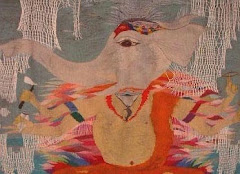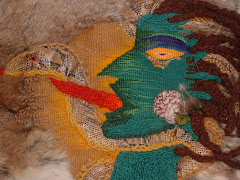
I headed down the sand road towards my home on the Cupeno Band of Mission Indians reservation in San Diego County, California. At the river crossing I paused. There’d been rain. I inched my Honda through water, more swift than usual, six-inches deep. Out of the river bed, my car burped and stuttered as I picked up speed down the trail, with barren land all around, chaparral-covered hills, an occasional tree, and a few homes and trailers on about an acre each. A couple of blond-gray coyote mixes trotted behind me as I pulled up next to “my” trailer, loaned to me for my year-long government-sponsored stint in 1977, teaching crafts to locals. One of my wishes was to inspire the older women to revive their basket-making tradition. They’d look down when I’d ask. “All the grass is on private land, now,” they’d say, meaning they could no longer harvest the reeds for weaving.
Pat, my neighbor, a pretty Native American, who worked in a high position for the Bureau of Indian Affairs, was heading over as I got out of my car. Her three-year old, face smeared with chocolate, hung onto her mom’s leg. Pat’s long, black hair was tangled and her black eyes not as bright as usual. “My dad died.”
I shook my head, put my hand over my mouth, and then gave her a hug, her body limp, arms at her sides.
“Come with me to the funeral?”
“Yeah…sure.”
I rode with her in her VW bug up the winding road to the La Jolla Reservation where her dad had been chief, a detail Pat had never told me. In fact she’d never told me about her dad in the several months that we’d been friends. We arrived just in time for the Air Force salute—another fact I’d not known, that her dad had been an Air Force pilot. Three fighter jets dove out of the sky, flying in formation, low, maneuvering between the low peaks of the Palomar Mountain Range, thundering by several times, wings dipping from side to side in salute.
We milled around for a while. I’d spotted the open coffin lying on a dusty knoll, off by itself. Then people began to line up and file past, pay their respects. “Come on,” said Pat. I cringed. Only dead person I’d ever visited was my grandfather, when I’d been five years old. I was afraid of dead. But now I had no choice. I got into the line. As my turn came I took a deep breath, held it. Then I looked down at the man lying there, dressed in an Air Force uniform. “Oh…” I thought. A slight smile came across my face. “There’s no one there.” Now captivated by my new understanding, I lingered and focused my attention on the empty shell of Pat’s dead father.
That night as I lay in bed waiting for sleep, I ran through the events of the funeral. In the very second my mind paused at the coffin scene, fascinated, I felt the Air Force pilot and chief, brush past me and then attempt to enter my body. “Jesus!” I thought as I sat bolt up, immediately remembering something my spiritual teacher had taught me. Loud and fast, I intoned, “whish, whish!” repeating over and over as I waved my arms and flapped my hands, for him to get out of there.
He obliged.
I don’t believe there’s a scientific explanation for my experience, and in most social settings, people do seem to need an explanation. Movies like “Sixth Sense” may attract a huge box-office draw, indicating that either people believe in spirits that don’t occupy bodies, or that they at least find the idea fascinating, or at best scary. Ghost stories around campfires are popular among campers. Native peoples around the world tell of departed spirits that tend to stick around. And, the belief that spirits might prefer to linger after death, is at least one of the reasons rituals are performed, to help the soul find its way after death, to help it find the light pathway, God.
Not all departed souls stay behind to haunt. In the Buddhist tradition, for instance, a person who has attained a high level of spiritual consciousness, might wish to help others from the “other side,” after they’ve passed out of the body. Saints who’ve died and serve as guideposts for people seeking insight on how to live well, how to remain optimistic in the face of life’s obstacles.
Yet the immediate question in my mind after my experience on the reservation, was about life after death, as it relates to a normal person like me. I remembered Raymond Moody’s book, Life After Life, about near death experiences. He made an in-depth study after discovering that the phenomenon of “almost dying” was more common than he realized. In fact, he concluded that about one in eight people who’d been “resuscitated, or had a similar brush with mortality, had at least one of the traits of an NDE [near death experience].” In his book he interviews people who’ve died and come back.
Moody has identified the following traits of people who’ve had near death experiences: out of body, accurate visual perception, audible sounds or voices, feeling of peace and painlessness, light phenomena, life review, being in another world, encountering other beings, tunnel experience, precognition.
I have spoken to two people I know well, who’ve had near death experiences.
My sister’s doctor told her, when she was ill with an intestinal pain, that if she began feeling euphoric it meant she was about to die and then she’d better call 911. She called 911. While on the operating table she says that she left her body and found herself in the most peaceful place she’d ever experienced, and that she now knew God. She didn’t want to return, but decided she must as her youngest child was only four. When she awoke, the nurse said, “You’re supposed to be dead.” My sister, once well, said that life was never the same after that, and that she no longer feared death.
I learned about another near death experience from a friend. As she told me the tale, her face took on a beatific glow that grew brighter and brighter as her story unfolded. She had become ill with a high fever and friends had taken her to the hospital. There my friend said she found herself rising above her body. “Then I rose up above the building, and then above the town, and then above the state, and then above the earth. And up into a blinding light… and I saw God...”
"You saw God? What was that like?"
She paused, shook her head.
"Please tell me."
"I can't now." She sat silent, eyes downcast. “I met some beings who told me I had to return, though I didn’t want to…after I came back I didn't feel driven by societal have-to's anymore. I did sense a tide swell to be of service, though, in however long or short my time remaining. The veil has remained thin for me, which is both a people-rich and a lonely journey.…” She smiled, looked up and then bubbled with laughter. “People who’ve had near death experiences have a certain light about them.”
Later my friend and I talked about it. I had felt ashamed about interrupting her, that maybe I'd have heard what her experience of God was like had I remained attentive and quiet. I asked her again to tell me. I could tell from her face, distant and soft, that she wasn't going to, that it wouldn't be possible to raise the same divine mood she had been in. She said that sometimes people are frightened to hear about the awe of a divine light, about life after death. Yet at the same time, I realized, they do want to know because they want to believe in a beyond, something that gives meaning to life, that will help them to live with passion, within the exquisite beauty of the earthly realm, its joys and anguish.
Saints and sages throughout the ages have told, in myriad ways, of the experience of God, and all admit that it is impossible to describe. One has to experience it. One Indian saint explained that such a question is like asking a salt doll to tell what it was like to be immersed into the ocean.
Photo credit: "Fog at Sand Beach" by Greg Hartford on AcadiaMagic.com






No comments:
Post a Comment